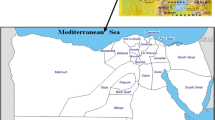Abstract
Water resource is scarce in most of the areas of Bangladesh during dry period due to changing climate impact. The shortage of water resources is endangering the recently achieved self-sufficiency of food production of Bangladesh. Thus, further research is necessary to increase water use efficiency and preserve the e-flow of rivers during the dry season while sustaining the stability of food production even at low usable water supply. The study was conducted to estimate irrigation requirements and irrigation scheduling for rice crop. The study area involved four districts (Cumilla, Brahmanbaria, Chandpur, and Feni) of the southeastern region of Bangladesh since 46.92% of the total land area is used for rice cultivation in this region. FAO developed CROPWAT 8.0 model was adopted for estimating irrigation water requirement, effective rainfall, and irrigation scheduling during Aus, Aman, and Boro rice. Historical climatic data including temperature, humidity, sunshine hours, wind speed (1981–2010) from three weather stations, and rainfall data from four rainfall stations were used as input to the model. The model calculated reference evapotranspiration (ETo) using the FAO Penman–Monteith method and USDA soil conservation method was used to find effective rainfall. Results showed that, Boro rice required the maximum irrigation than other seasons due to less seasonal rainfall. T. Aus rice estimated irrigation water in its early growing period, whereas T. Aman rice estimated it in later growing period because of ununiformed rainfall distribution. Boro rice demanded irrigation in its whole growing period in each study location. Practically, farmers applied more irrigation water to their rice field than the model estimated amount. This was the result of lack of farmers’ knowledge about water management technologies. This study found the model suitable for generating irrigation schedule with the necessary split application dates without yield reduction. CROPWAT model has the potentiality to make appropriate irrigation scheduling and save irrigation water. It will save huge energy, cost of production and reduces pressure on water sources.
Access this chapter
Tax calculation will be finalised at checkout
Purchases are for personal use only
Similar content being viewed by others
References
Sharma B, Molden D, Cook S (2015) Water use efficiency in agriculture: measurement, current situation and trends. Manag water Fertil Sustain Agric Intensif 39–64
Smith M (1991) CROPWAT: Manual and guidelines. FAO UN, Rome
Karuppanan S (2018) Determination of Water Requirements of Main crops in the Tank Irrigation Command area using CROPWAT 8 . 0 Determination of Water Requirements of Main crops in the Tank Irrigation Command area using
Surendran U, Sushanth CM, Mammen G, Joseph EJ (2015) Modelling the Crop Water Requirement Using FAO-CROPWAT and Assessment of Water Resources for Sustainable Water Resource Management: A Case Study in Palakkad District of Humid Tropical Kerala, India. Aquat Procedia 4:1211–1219. https://doi.org/10.1016/j.aqpro.2015.02.154
Barrow CJ (2016) Water resources and agricultural development in the tropics. Routledge
International Rice Research Institute (IRRI): Annual Report 2012,International Rice Research Institute (IRRI) (2012). DAPO Box 7777, Metro Manila, Philippines
Guerra LC (1998) Producing more rice with less water from irrigated systems. IWMI
Dawe DC, Hardy B, Hettel GP (2002) Rice Almanac: source book for the most important economic activity on earth. Rice Alm source B Most important Econ Act earth. https://doi.org/10.1079/9780851996363.0000
Boutraa T (2010) Improvement of water use efficiency in irrigated agriculture: a review. J Agron 9:1–8
Bangladesh Bureau of Statistics (BBS) (2017) Yearbook of Agricultural Statistics. People’s Republic Bangladesh, Stat Informatics Div Ministry of Planning, Govt, p 360
Bridges M (2014) Soil Texture. Encycl. Environ. Chang. 1028–1030
Bangladesh Rice Knowledge Bank (BRK), Bangladesh Rice Research Institute (BRRI), Gazipur
Hossain M, Yesmin S, Maniruzzaman M, Biswas J (2017) Irrigation Scheduling of Rice (Oryza sativa L.) Using CROPWAT Model in the Western Region of Bangladesh. Agric 15:19–27. https://doi.org/10.3329/agric.v15i1.33425
Allen RG, Pereira LS, Raes D, Smith M (1998) Crop evapotranspiration-Guidelines for computing crop water requirements-FAO Irrigation and drainage paper 56. Fao, Rome 300:D05109
Pongpinyopap S, Mungcharoen T (2012) Comparative Study of Green Water Footprint Estimation Methods for Thailand: A Case Study of Cassava-based Ethanol. Environ Nat Resour 10:66–72
Land, FAO (1997) Irrigation potential in Africa; A basin approach. 4
Acknowledgements
We thank Dr. Md. Ruhul Amin for his continuous guidance, support, and mentorship. We also thank Waqar Hassan Khan for hel** with data analysis using Python.
Author information
Authors and Affiliations
Editor information
Editors and Affiliations
Rights and permissions
Copyright information
© 2022 The Author(s), under exclusive license to Springer Nature Singapore Pte Ltd.
About this paper
Cite this paper
Amin, R.A., Hossain, M.B., Yunus, A. (2022). Estimation of Crop Water Requirement and Irrigation Scheduling of Rice in Southeastern Region of Bangladesh Using FAO-CROPWAT 8.0. In: Arthur, S., Saitoh, M., Pal, S.K. (eds) Advances in Civil Engineering. Lecture Notes in Civil Engineering, vol 184. Springer, Singapore. https://doi.org/10.1007/978-981-16-5547-0_40
Download citation
DOI: https://doi.org/10.1007/978-981-16-5547-0_40
Published:
Publisher Name: Springer, Singapore
Print ISBN: 978-981-16-5546-3
Online ISBN: 978-981-16-5547-0
eBook Packages: EngineeringEngineering (R0)




